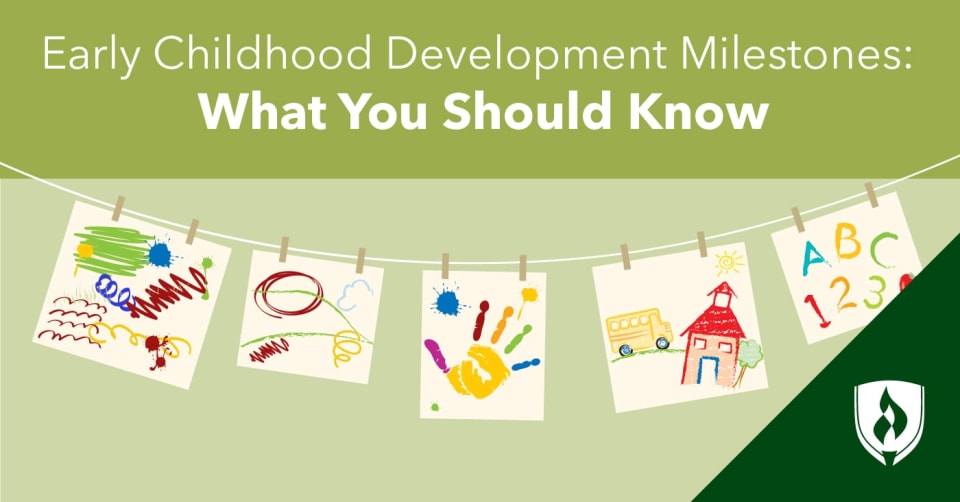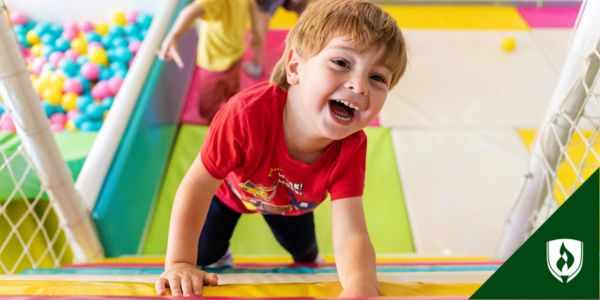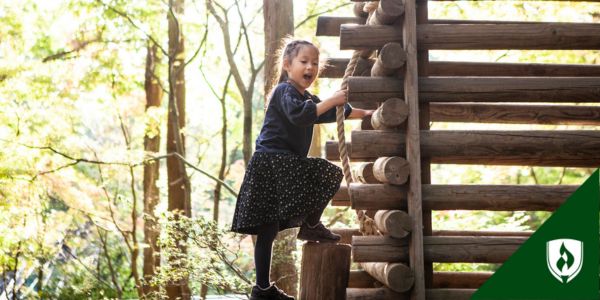
If you’ve ever spent time with young children, you already know they are amazing learners. They develop new skills and vocabulary at what seems to be a hundred miles per hour. Young children absorb information and learn in many different ways simultaneously.
For example, while a toddler is learning important physical skills and coordination—they’re also developing speech, studying social cues and learning emotional expression. It’s remarkable how much those little minds can take in at once. This is one of the many reasons early childhood education is so important.
If you’re a parent, you’ve probably heard quite a bit about some of these child developmental milestones already. Doctors, teachers and all sorts of professionals who interact with kids keep an eye out for important changes as children grow. But even if you’ve studied up on early childhood development, keeping track of important milestones can seem overwhelming.
We compiled this resource to help you understand all of the important child development stages little ones go through and what milestones to look for along the way. Additionally, discover how concepts like social referencing play a vital role in child development.
Why is early childhood development important?
You can probably guess why children need to develop and grow as they go along. They can’t stay infants forever, no matter how cute they are. But professionals who work with children are much better equipped to help them learn if they understand how they grow.
“By being aware of development, educators and caregivers can understand what types of environments children need,” says Dr. Dawn-Elise Snipes, PhD, LMHC, LPC-MHSP, EIP and host of Counselor Toolbox Podcast.
Fostering the right environment can help children develop self-esteem while also explaining some of their behaviors, Dr. Snipes explains. “Understanding early childhood development can help you more effectively support your young ones, but more importantly, it helps children develop a strong sense of confidence and determination.”
When you have a strong foundation for what is going on in those little minds—you’ll have a much better idea of what they need to flourish. There is also a benefit to catching any development trouble early on.
“Early childhood education professionals need to know how to use screening tools when they suspect a delay may be present, and how to support parents in seeking help,” says Dr. Ari Yares, PhD, NCSP and psychologist.
The Centers for Disease Control and Prevention (CDC) says that significant delays in development can be indicators of a medical or psychological condition. Catching potential underlying causes early can allow parents and caregivers to get support for their child and better understand how to adjust to their needs. According to the CDC, certain therapies and interventions will be much more effective early in a child’s life, when their brain is most adaptable.1 This makes early childhood education an ideal stage for keeping an eye on what those little ones are learning.
Important areas of early childhood development
Early childhood development is a little easier to understand when you break it into categories of learning. The CDC separates early learning abilities into four primary areas:1
- Social and emotional
- Language/communication
- Movement/physical development
- Cognitive (learning, thinking, problem-solving)
In healthy children, these areas are all important in growth and development. When you consider a learning environment, these growth areas intersect. For example, social and emotional awareness often increases through language and communication in the preschool years. Or toddlers might problem-solve and make cognitive discoveries through movement and physical growth.
But when you understand development as a whole, you see that educating children goes way beyond letters and numbers. “We often focus on creating a language-rich environment using colors, numbers and shapes, but leave out building a child’s emotional vocabulary,” Dr. Yares suggests.
Leaving an important element—like emotional expression—out of the picture can make learning more difficult for young students. “ECE professionals need to understand the full gamut of early childhood development, since emotional expression is often tied to behavioral difficulties we see in young children,” Dr. Yares says.
While there are certain child development milestones to keep an eye out for (e.g., beginning to make sentences or learning to walk), experts in early childhood education experts warn against measuring all children against a checklist.
“Understand that development does not happen in a neat, linear fashion like textbooks or charts describe,” Dr. Yares explains. “It is uneven and varies from child to child, even within the same family.” He advises early childhood professionals to understand important time frames and milestones, while learning about how development works at a more holistic level.
Early childhood development milestones to watch for
The CDC outlines common early childhood development milestones laid out by the age range when these changes typically occur. If you have a rough idea of what to expect from children as they reach these milestones, you will be better equipped to work with children and keep an eye out for healthy growth.
Milestones at 2 – 4 months old1
- Try to look at parents; begin to smile
- Copy some movements and facial expressions
- Turns head toward sounds
- Tracks movement with their eyes
- Starts to babble
- Holds head up, can push up while lying on tummy
Milestones at 6–9 months old1
- Recognize faces
- Sit without support
- Have favorite toys
- Can pick up objects between thumb and index finger
- Pull themselves to stand while holding on to objects
Milestones at one year old1
- Are often shy or nervous with strangers
- Use simple gestures
- Say “mama” and/or “dada”
- Follow simple directions like, “Pick up that toy.”
- Find hidden items easily
- May stand or take a few steps without support
Milestones at 18-months old1
- Initiate play by handing things to others
- Point at what they want
- Say several single words
- Know how ordinary objects (telephone, spoon) are used
- Eat with spoons and drink with cups
Milestones at two years old1
- Show excitement around other kids
- Repeat words or sentences often overheard
- Begin to sort shapes and colors
- Begin to run, climb, throw and stand on tiptoe
Milestones at three years old1
- Exhibit a wide range of emotions
- Show concern for others
- Follow instructions with two or three steps
- Play make-believe
- Dress and undress themselves
Milestones at four years old1
- Enjoy trying new things and talking about interests
- Know some basic grammar rules
- Start to understand time and the idea of counting
- Pour, cut and mash their food with supervision
Milestones at five years old1
- Like to sing, dance and playact
- Speak clearly in full sentences
- Can print some letters or numbers
- Can use the toilet on their own
Applying early childhood development to the care environment
Whether you are teaching young ones, keeping them safe and busy in a care center, or even raising one of your own, understanding childhood development stages can make a great impact on how you relate with little ones.
“ECE professionals are uniquely positioned to help children develop an emotional vocabulary through activities like reading and by describing behavior and feelings happening in the classroom,” Dr. Yares explains. “This is directly linked to the support that young children need in expressing their wants and needs and dealing with the emotional reactions.”
Dr. Snipes adds that preschool-aged children tend to think very egocentrically and in “all-or-nothing terms.” She stresses the importance of speaking in concrete terms so children do not feel responsible for something that may not be their fault. When teachers understand how children develop, they’ll know to separate the child from the behavior to prevent children from internalizing harmful messages.
Looking at how children grow and what they need at different stages of development will also help teachers see a bigger picture of education. Dr. Snipes emphasizes that needs like sleep and nutrition have a huge impact on a child’s ability to learn and manage their emotions. When teachers partner with parents and caregivers, these aspects of early childhood development will be helpful to provide the best support possible for every child.
Supporting early childhood development
Now you’re aware of some significant early childhood development milestones and the importance of understanding these stages children advance through. While these are accepted as general guidelines, remember that every child is unique.
If you’re excited at the thought of helping children grow and develop in their own way, perhaps you have a future in doing just that! Find out if you’d be a good fit in our article, “6 Signs You Have What It Takes to Become a Childcare Provider.”
Additionally, check out our other articles "Speech Delay in Toddlers: What ECE Professionals Should Know" and "Early Childhood Mental Health: 8 Things ECE Professionals Should Know".
See how your Early Childhood Education degree can nurture the lives of young children.
Learn More About Our ECE Bachelor's DegreeRelated Articles:
- Math Skills for Preschoolers: 4 Ways to Set the Stage for Success
- Science for Preschoolers: 9 Fun Activities to Help Spark Curiosity
- Speech Delay in Toddlers: What ECE Professionals Should Know
1Centers for Disease Control and Prevention, Department of Health and Human Services, Learn the Signs. Act Early. Developmental Milestones. [Information accessed August 2020.] https://www.cdc.gov/ncbddd/actearly/milestones/index.html
EDITOR’S NOTE: This article was originally published in 2018. It has since been updated with information relevant to 2020. Insight from Dr. Snipes and Dr. Yares remains from original.




